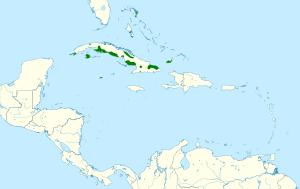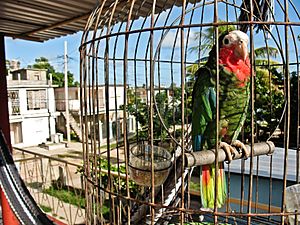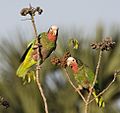Cuban amazon facts for kids
Quick facts for kids Cuban amazon |
|
|---|---|
 |
|
| A. l. leucocephala in Cuba | |
| Conservation status | |
| Scientific classification | |
| Genus: |
Amazona
|
| Species: |
leucocephala
|
 |
|
| Range in green | |
| Synonyms | |
|
Psittacus leucocephalus Linnaeus, 1758 |
|
The Cuban amazon (Amazona leucocephala) is a medium-sized green parrot. People also call it the Cuban parrot or the rose-throated parrot. You can find these parrots in forests in Cuba, the Bahamas, and the Cayman Islands. Sometimes, they are seen in Puerto Rico, but these are usually pet parrots that have escaped.
Contents
About the Cuban Amazon
How it Got its Name
The Cuban amazon was first officially described in 1758. A Swedish scientist named Carl Linnaeus gave it the scientific name Psittacus leucocephalus. He wrote about it in his famous book, Systema Naturae. The name leucocephala comes from ancient Greek words meaning "white" and "crest." This refers to the white feathers on its head.
Today, the Cuban amazon is part of a group of about 30 parrot species. This group is called Amazona.
Different Kinds of Cuban Amazons
There are different types of Cuban amazons, called subspecies. They look a bit different depending on where they live. Here are the main ones:
- A. l. leucocephala: This type lives all over Cuba, including Isla de la Juventud.
- A. l. bahamensis: This type lives in the Bahamas. You can find them on the Abaco Islands and Great Inagua. Some used to live on other islands but are no longer there.
- A. l. caymanensis: This type lives only on Grand Cayman Island.
- A. l. hesterna: This type lives on Cayman Brac island. It used to live on Little Cayman too.
Scientists have studied these parrots closely. They found that some groups, especially in the Bahamas, might be even more distinct. This means there could be more subspecies than we currently recognize!
What They Look Like
The Cuban amazon is about 28 to 33 centimeters (11 to 13 inches) long. It is mostly green. Its wings have some blue feathers. The edges of its green feathers are black, making them look neat.
Its lower face, chin, and throat are a pretty rosy pink. Its forehead and the rings around its eyes are white. The amount of pink, white, and red on their bodies can change between the different subspecies.
Their eyes are a pale olive-green. Their beak is horn-colored, and the feathers near their ears are blackish. Their legs are pink. Young parrots (juveniles) have less red on their bellies. They also have less black on their green feathers. Some young birds might have pale yellow feathers on their heads instead of white.
Where They Live
Cuban amazons live in different places depending on the island.
- In Cuba, they used to be found everywhere. Now, they mostly live in the forested areas of the main island and Isla de la Juventud. There are about 10,000 Cuban amazons in Cuba.
- On the Cayman Islands, they live in dry forests and on farms. About 3,400 parrots live on Grand Cayman. On Cayman Brac, there are about 400 to 500 parrots. Sadly, they are no longer found on Little Cayman.
- In the Bahamas, about 3,550 parrots live on Abaco and 6,350 on Inagua. They used to live on other Bahamian islands too, but they are gone from those places now.
How They Behave
In winter, Cuban amazons gather in large groups. When it's time to have babies, they split up into pairs.
What They Eat
Cuban amazons eat many different fruits and seeds. They especially like the fruits from palm trees. They also enjoy seeds from the West Indian mahogany tree.
How They Breed
The breeding season for these parrots is from March to September. Most Cuban amazons build their nests in holes in trees. However, the parrots on the Abaco Islands are special. They nest underground in holes in the limestone rock. This helps protect their nests from wildfires that can happen in the pine forests.
Females lay two to four white eggs. The mother parrot sits on the eggs for about 26 to 28 days until they hatch.
Their Protection Status
The Cuban amazon is considered "Near Threatened" by the IUCN Red List. This means they could become endangered if we don't protect them. Their numbers are decreasing because of:
- Habitat loss: Their homes (forests) are being cut down.
- Natural disasters: Hurricanes and other storms can harm their populations.
- Trapping: Some people illegally catch them to sell as pets.
To help protect them, the Cuban amazon is listed on Appendix I of CITES. This means it's against the law to buy or sell these wild parrots internationally.
Cuban Amazons as Pets
For a long time, it was rare to see Cuban amazons as pets outside of Cuba and Florida. They are known to be a bit tricky to breed in captivity. Sometimes, the male parrots can be aggressive towards their mates or even their own baby chicks.
These parrots became more popular as pets in Russia after the Soviet Union ended. Many Russian soldiers brought them back from Cuba. Even though they are more available now, Cuban amazons are still one of the most expensive amazon parrots to buy.
In the Cayman Islands, these parrots are called Cayman parrots. Sometimes, people illegally take them from the wild to keep as pets. In 2020, the government held an "amnesty" program. This allowed parrot owners to register their pets legally. The registered parrots got health checks and special chips or leg bands. This helps tell them apart from wild birds. During this program, 326 parrots were registered!
Gallery
-
A. l. caymanensis, Grand Cayman
-
A. l. caymanensis, Grand Cayman
-
At Palmitos Park, Gran Canaria, Spain
See also
 In Spanish: Loro cubano para niños
In Spanish: Loro cubano para niños







